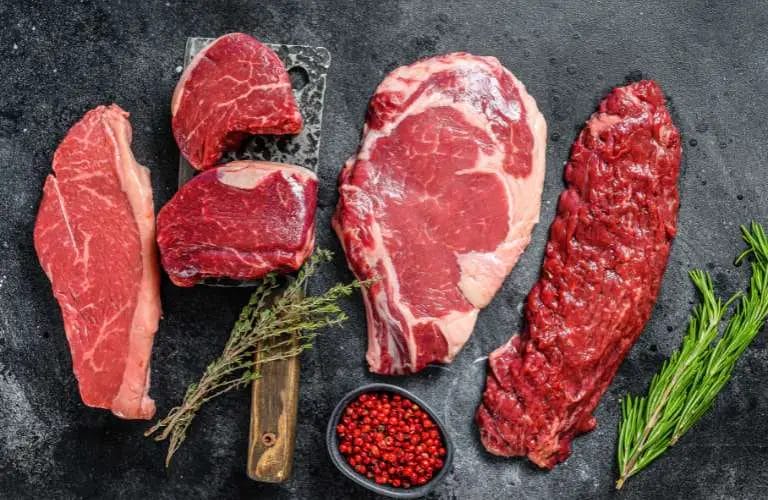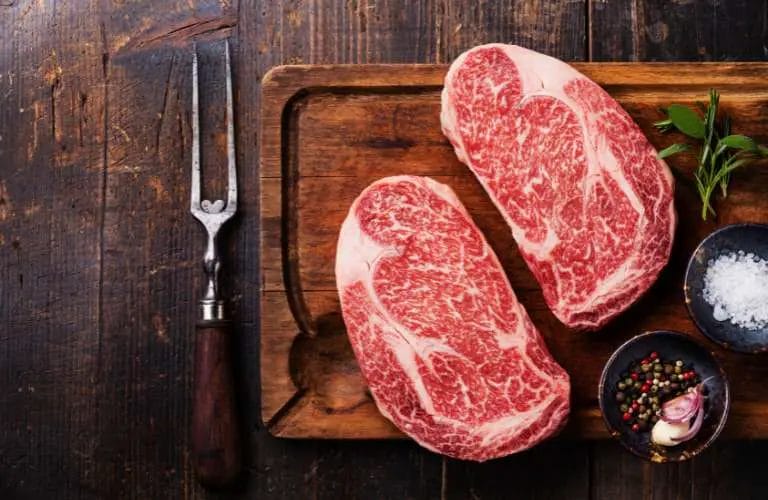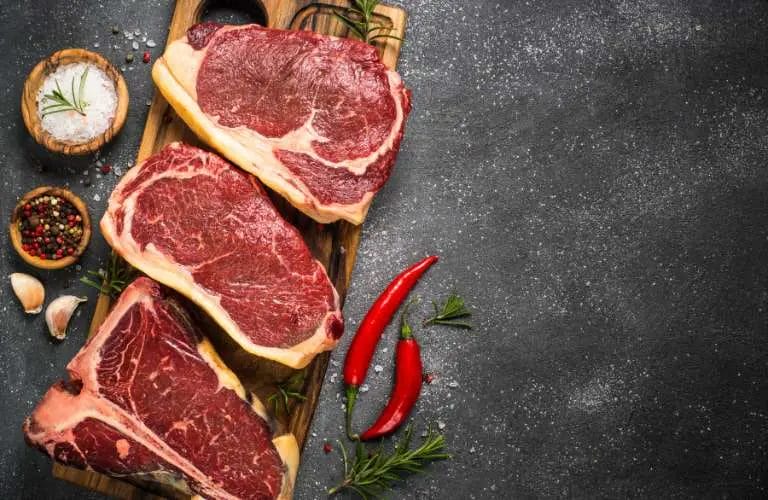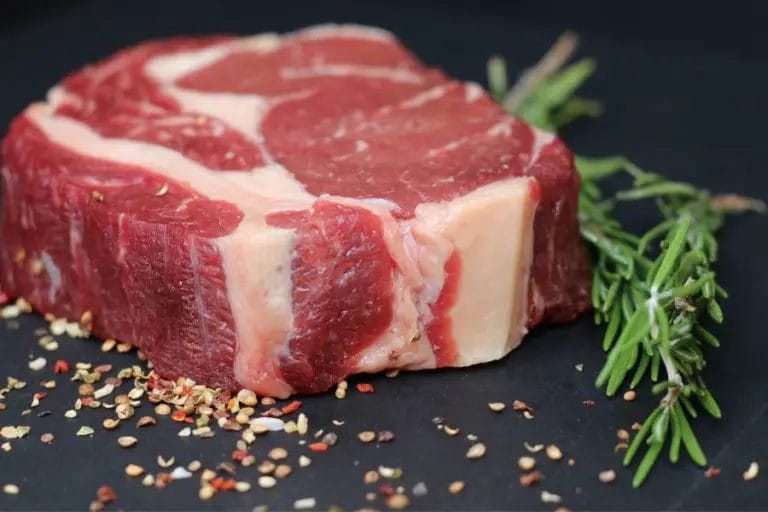If you’re wondering how long raw steak can sit out, it’s important to consider food safety guidelines. Raw steak should not be left out at room temperature for more than two hours.
Leaving it out for longer can increase the risk of bacterial growth, which can lead to foodborne illnesses. To ensure safety, it’s best to refrigerate raw steak promptly or cook it immediately after purchasing.

Safe Storage Guidelines: Properly Storing Raw Steak to Avoid Spoilage
Raw steak is a delicious and versatile meat that requires proper storage to maintain its quality and prevent spoilage. Whether you have purchased steak from a local butcher or have leftovers from a cookout, it is essential to follow safe storage guidelines to ensure the freshness and safety of the meat.
In this section, we will discuss the steps you can take to store raw steak properly and avoid spoilage.
1. Keep it Refrigerated
The most critical aspect of storing raw steak is to keep it refrigerated at all times. Raw meat is highly perishable and can quickly spoil if not kept at the right temperature.
Store the steak in a clean, airtight container or wrap it tightly in plastic wrap to prevent air and moisture from entering and causing bacterial growth.
Make sure that your refrigerator is set to a temperature of 40°F (4°C) or below. This temperature range inhibits the growth of bacteria and helps to maintain the freshness of the meat. It is advisable to place the steak on the bottom shelf of the refrigerator to prevent any drips from contaminating other foods.
2. Separate and Label
When storing raw steak, it is essential to keep it separate from other foods to avoid cross-contamination.
Raw meat can contain harmful bacteria such as Salmonella or E. coli, which can spread to other foods if not handled properly. Store the steak in a separate section of the refrigerator away from ready-to-eat foods or fruits and vegetables.
Labeling the steak with the date of purchase or storage will help you keep track of its freshness. It will also be helpful if you have multiple types of meat in your refrigerator, ensuring that you use the oldest steak first to prevent any wastage.
3. Freeze for Long-Term Storage
If you have excess raw steak that you would like to store for an extended period, freezing is the best option. Freezing not only helps to maintain the freshness of the meat but also extends its shelf life.
Before freezing, make sure to wrap the steak tightly in moisture-proof and airtight packaging such as freezer bags or aluminum foil.
When freezing raw steak, it is advisable to divide it into smaller portions for convenience. This way, you can thaw only the amount you need without having to defrost the entire piece. Remember to label each package with the date of freezing to keep track of its storage time.
4. Thaw Properly
When you are ready to cook the frozen raw steak, it is crucial to thaw it properly to maintain its quality and safety. The ideal method to thaw steak is in the refrigerator. Simply transfer the wrapped steak from the freezer to the refrigerator and allow it to thaw gradually overnight or for several hours.
Alternatively, you can also use the defrost setting on your microwave to thaw the steak quickly. However, it is essential to cook the steak immediately after thawing using this method to avoid any bacterial growth.
5. Use it within the Recommended Time
To ensure the best taste and quality, it is recommended to use raw steak within a certain timeframe. Fresh steak should be consumed within 3 to 5 days when properly stored in the refrigerator.
Frozen steak, on the other hand, can last for up to 6 to 12 months, depending on the type of packaging and freezer temperature.
It is important to note that these timeframes are only guidelines, and the freshness of the steak also depends on factors such as initial quality and handling. Always use your discretion and inspect the meat for any signs of spoilage before consuming.

Understanding Temperature Danger Zone: How Long is it Safe to Keep Raw Steak Out?
When it comes to food safety, understanding the temperature danger zone is essential to prevent foodborne illnesses.
The temperature danger zone refers to the range of temperatures in which bacteria multiply rapidly and can lead to food poisoning. For raw steak, it is crucial to know how long it is safe to keep it out of refrigeration to avoid potential health risks.
The temperature danger zone for food is between 40°F (4°C) and 140°F (60°C). Within this temperature range, bacteria, such as Salmonella and E. coli, can double in number every 20 minutes. Raw steak, being a perishable food item, is particularly vulnerable to bacterial growth if not handled properly.
It is recommended to keep raw steak refrigerated at a temperature below 40°F (4°C) to slow down bacterial growth and maintain its freshness. However, there may be instances when you need to keep the steak out of refrigeration temporarily, such as during meal preparation or when marinating the meat.
The general rule of thumb is to minimize the time raw steak spends in the temperature danger zone. Ideally, it should not be left out at room temperature for more than 2 hours. Beyond this time frame, the risk of bacterial contamination increases significantly.
However, several factors can affect the safety of leaving raw steak out of refrigeration, including the ambient temperature, humidity, and the initial quality of the meat.
For example, if the room temperature is relatively high or there is excessive moisture, bacteria can grow faster, shortening the safe time limit for keeping the steak out.
To ensure the safety of raw steak, it is essential to follow proper food handling practices. Here are some guidelines:
- Always store raw steak in the refrigerator at or below 40°F (4°C) until ready to use.
- Thaw frozen steak in the refrigerator or using the defrost function of the microwave to prevent it from entering the temperature danger zone.
- If marinating the steak, do it in the refrigerator to minimize the time it spends in the temperature danger zone. Alternatively, use vacuum-sealed bags or resealable plastic bags to marinate the meat and eliminate direct contact with the marinade.
- During meal preparation, take out only the amount of steak you need and return the rest to the refrigerator promptly.
- When cooking steak, use a food thermometer to ensure it reaches a safe internal temperature. The USDA recommends cooking beef to a minimum internal temperature of 145°F (63°C) for medium-rare.

Best Practices for Handling Raw Meat: Preventing Foodborne Illnesses
Raw meat is a common ingredient in many dishes and provides a valuable source of protein. However, improper handling and preparation of raw meat can lead to foodborne illnesses caused by harmful bacteria such as Salmonella, E. coli, and Campylobacter.
To ensure food safety and prevent the risk of foodborne illnesses, it is essential to follow best practices when handling raw meat.
1. Purchase and Storage
When purchasing raw meat, choose cuts that are fresh, well-packaged, and properly refrigerated. Ensure that the packaging is intact and not expired. It is advisable to purchase meat at the end of your shopping trip to minimize the time it spends outside of a refrigerated environment.
Once you bring the raw meat home, promptly store it in the refrigerator or freezer. Keep raw meat separate from other food items to prevent cross-contamination. Store raw meat on the lowest shelf in the refrigerator to prevent any drippings from contaminating other foods.
2. Proper Thawing
If you need to thaw frozen raw meat, it is important to do so safely to avoid bacterial growth. The best method is to thaw the meat in the refrigerator overnight.
This slow thawing process helps maintain a safe temperature and prevents the growth of harmful bacteria. If you are short on time, you can also use a microwave to defrost the meat, but be sure to cook it immediately afterward.
Avoid thawing raw meat at room temperature as it can promote the growth of bacteria. Additionally, do not refreeze thawed meat without cooking it first, as this can further increase the risk of bacterial contamination.
3. Separate Cutting Boards and Utensils
When handling raw meat, it is vital to prevent cross-contamination by using separate cutting boards and utensils for different food items.
Designate one cutting board for raw meat and another for fruits, vegetables, or cooked food. This practice ensures that bacteria from the raw meat do not come into contact with ready-to-eat foods.
Similarly, use separate utensils such as knives and tongs for handling raw meat and cooked food. Thoroughly wash cutting boards and utensils with hot, soapy water after each use to remove any bacteria present on the surfaces.
4. Safe Handling and Cooking
During food preparation, maintain good hygiene by washing your hands thoroughly with soap and water before and after handling raw meat. This simple practice helps prevent the transfer of bacteria from your hands to the meat or other surfaces.
When cooking raw meat, it is crucial to ensure that it reaches a safe internal temperature to kill any harmful bacteria. Use a food thermometer to accurately measure the temperature. The following are the minimum safe internal temperatures for popular types of meat:
| Meat Type | Minimum Safe Internal Temperature (Fahrenheit) |
|---|---|
| Chicken, turkey, and other poultry | 165°F |
| Ground meat | 160°F |
| Pork, veal, and lamb | 145°F |
| Beef, veal, and lamb (steaks, roasts, and fish) | 145°F (medium-rare) to 160°F (medium) |
After cooking, allow the meat to rest for a few minutes before cutting or serving to ensure that it cooks evenly and reaches the desired internal temperature.
5. Cleaning and Sanitizing
Proper cleaning and sanitizing of kitchen surfaces, utensils, and equipment are essential to prevent the spread of bacteria. Wash countertops, cutting boards, and utensils with hot, soapy water after each use. Consider using separate cleaning cloths for different areas to avoid cross-contamination.
To sanitize surfaces, prepare a solution of one tablespoon of unscented chlorine bleach mixed with one gallon of water. Use this solution to wipe down countertops, cutting boards, and utensils. Allow the surfaces to air dry or use disposable paper towels to prevent the spread of bacteria.
6. Storing Leftovers
If you have any leftovers from cooked meat, it is important to handle and store them properly to prevent bacterial growth

Factors Affecting the Shelf Life of Raw Steak: Moisture, Humidity, and Air Exposure
When it comes to the shelf life of raw steak, several factors come into play. The quality and freshness of the meat can significantly impact how long it can be stored before it spoils.
However, three key factors are known to have a significant effect on the shelf life of raw steak: moisture, humidity, and air exposure.
1. Moisture
Moisture plays a crucial role in determining the shelf life of raw steak. Excess moisture can lead to bacterial growth and spoilage. To extend the shelf life of raw steak, it is essential to control the moisture content. This can be achieved by ensuring proper packaging and storage conditions.
One common method to control moisture is to wrap the raw steak in moisture-absorbing materials such as paper towels or butcher paper before placing it in a plastic bag or container. This helps to absorb excess moisture and prevent the growth of bacteria that can cause spoilage.
It is also important to handle raw steak with clean, dry hands to avoid introducing additional moisture. Excess moisture from handling can promote bacterial growth and reduce the shelf life of the meat.
2. Humidity
Humidity refers to the amount of moisture present in the air. High humidity levels can accelerate the spoilage process by creating a favorable environment for bacteria to thrive. On the other hand, low humidity levels can cause the meat to dry out and lose its quality.
To maintain the optimal humidity level for raw steak storage, it is recommended to store the meat in a refrigerator or a cool, dry place. Refrigerators typically have a controlled humidity setting that helps to keep the meat fresh for a longer period.
Additionally, storing the raw steak in airtight containers can help to regulate the humidity levels and prevent moisture loss.
It is crucial to note that excessive humidity can lead to the growth of mold on the surface of the raw steak. To prevent this, it is important to monitor the humidity levels regularly and adjust storage conditions accordingly.
3. Air Exposure
Air exposure is another critical factor that can affect the shelf life of raw steak. When raw meat comes into contact with air, it oxidizes, leading to changes in color, texture, and flavor. Exposure to air can also introduce bacteria and other contaminants, further reducing the shelf life of the meat.
To minimize air exposure, it is recommended to wrap raw steak tightly in plastic wrap or place it in vacuum-sealed bags.
Vacuum sealing removes excess air and creates a barrier between the meat and the surrounding environment. This helps to preserve the freshness and quality of the raw steak for a longer duration.
For optimal shelf life, it is important to store raw steak in airtight containers or freezer bags to prevent air from reaching the meat. Additionally, storing the meat on the lower shelves of the refrigerator, away from other strong-smelling foods, can further reduce the risk of contamination and prolong its shelf life.
Tips for Ensuring Freshness: Checking the Quality of Raw Steak Before Cooking
When it comes to cooking a delicious steak, the freshness and quality of the meat play a crucial role in determining the final outcome.
Whether you’re hosting a dinner party or simply enjoying a meal at home, it’s important to ensure that your raw steak is of the highest quality before you start cooking. In this section, we will provide you with some useful tips on how to check the quality of raw steak to ensure its freshness and taste.
1. Appearance
One of the first things you should look out for when checking the quality of raw steak is its appearance. A fresh, high-quality steak will have a vibrant red color.
Avoid steaks that are discolored or have a brownish tint, as this could be a sign of spoilage. Additionally, steer clear of steaks with excessive fat or gristle, as these can affect the texture and taste of the meat.
2. Firmness
Another important factor to consider is the firmness of the raw steak. Gently press the steak with your fingertips – a fresh steak should feel firm and springy.
If the meat feels soft or mushy, it may indicate that it has started to spoil. Opt for steaks that have a good level of firmness to ensure a tender and juicy end result.
3. Odor
The smell of the raw steak can also provide valuable insights into its freshness. Fresh steak should have a clean, slightly metallic odor.
If you notice any unpleasant or sour smells, it’s best to avoid cooking that particular piece of meat, as it could be a sign of bacterial growth or spoilage. Trust your sense of smell and opt for steaks that have a neutral or pleasant aroma.
4. Marbling
Marbling refers to the tiny streaks of fat within the muscle tissue of the steak. It plays a significant role in enhancing the flavor, tenderness, and juiciness of the cooked steak.
When selecting a raw steak, look for a good amount of marbling throughout the meat. The fat should be evenly distributed and not overly concentrated in one area. The presence of marbling indicates a high-quality, well-aged steak.
5. Packaging
The packaging of the raw steak can also provide clues about its freshness. Inspect the packaging for any signs of damage, leaks, or excessive moisture. It should be securely sealed and free from any punctures or tears.
Additionally, check the expiration date or “use by” date on the packaging to ensure that the steak is within its prime freshness period.
By following these tips and guidelines, you can ensure that the raw steak you choose for cooking is of the highest quality and freshness. This will not only enhance the taste and texture of your final dish but also ensure that you are providing a safe and enjoyable dining experience for yourself and your guests.
Remember, investing a little time in checking the quality of raw steak can go a long way in achieving culinary perfection!

FAQs
How long can raw steak sit out?
Raw steak should not be left at room temperature for more than two hours. Bacteria can grow rapidly between 40°F (4°C) and 140°F (60°C), which is known as the “danger zone”. To prevent foodborne illnesses, it is best to refrigerate or cook raw steak within this time frame.
Conclusion:
In conclusion, the duration for which raw steak can safely sit out at room temperature is limited. It is recommended to keep raw steak refrigerated and avoid leaving it out for more than two hours.
Leaving raw steak at room temperature for extended periods can lead to the growth of harmful bacteria, increasing the risk of foodborne illnesses. To ensure food safety, it is always best to store raw steak properly and cook it thoroughly before consumption.
Remember, the quality and safety of your food should always be a priority. Proper handling and storage techniques are crucial in preventing bacterial growth and maintaining the freshness of raw steak. By following these guidelines, you can enjoy your steak without compromising your health.

